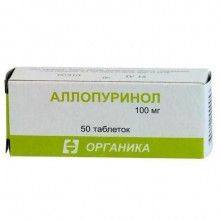



Hypouricemic, arthropod. A means of violating the synthesis of uric acid.
Allopurinol is a structural analogue of hypoxanthine. Inhibits the enzyme xanthine oxidase, which is involved in the conversion of hypoxanthin to xanthine and xanthine to uric acid. This is due to a decrease in the concentration of uric acid and its salts in body fluids and urine, which helps dissolve existing urate deposits and prevent their formation in tissues and kidneys. Allopurinol increases the excretion of hypoxanthin and xanthine with urine.
Hyperuricemia, primary and secondary gout, urolithiasis with the formation of uric acid stones, hemablastoma, cytostatic and radiation therapy of tumors, psoriasis, traumatic toxicosis, corticosteroid therapy to prevent uric acid nephropathy, malignant neoplasms and congenital disorders of purine metabolism in children.
1 tablet contains 100 mg of allopurinol;
auxiliary ingredients: lactose, starch, polyvidone, talc, magnesium stearate, sodium amylopectin glycolate.
Allopurinol is marketed under different brands and generic names, and comes in different dosage forms:
| Brand name | Manufacturer | Country | Dosage form |
|---|---|---|---|
| Allopurinol | Organica | Russia | pills |
| Allopurinol-Egis | Egis | Hungary | pills |
No customer reviews for the moment.
Begin with 100 mg / day, once, then gradually increase the dose. If, at a dose of 300 mg per day, side effects from the gastrointestinal tract occur, fractional administration is possible.
Inside, after eating.
Adults: 100-200mg per day, with a state of moderate severity, 300-600mg per day, in severe condition -700-900mg per day. Frequency of admission 2-4 times / day after meals.
Children: up to 15 years-10-20mg / kg per day (up to 400mg per day maximum) With severe renal insufficiency, 100mg per day or 100mg with an interval of more than 1 day.
Older patients are recommended the lowest dose.
Since the cardiovascular system: in rare cases - arterial hypertension, bradycardia.
From the digestive system: dyspeptic phenomena (including nausea, vomiting), diarrhea, transient increase in serum transaminase activity are possible; rarely, hepatitis; in rare cases, stomatitis, abnormal liver function (transient increase in transaminase and alkaline phase activity), steatorrhea.
From the side of the central nervous system and peripheral nervous system: in rare cases - weakness, fatigue, headache, dizziness, ataxia, drowsiness, depression, coma, paresis, paresthesias, convulsions, neuropathy, visual disturbances, cataracts, changes in the optic papilla, disorders of taste.
From the hemopoietic system: in some cases - thrombocytopenia, agranulocytosis and aplastic anemia, leukopenia (most likely in patients with impaired renal function).
From the urinary system: rarely interstitial nephritis; in isolated cases - edema, uremia, hematuria.
On the part of the endocrine system: in rare cases - infertility, impotence, gynecomastia, diabetes.
Metabolism: in isolated cases - hyperlipidemia.
Allergic reactions: skin rash, hyperemia, itching; in some cases - angioimmunoblastic lymphadenopathy, arthralgia, fever, eosinophilia, fever, Stevens-Johnson syndrome, Lyell's syndrome.
Dermatological reactions: in rare cases - furunculosis, alopecia, hair bleaching.
Hypersensitivity, severe renal failure, pregnancy and breastfeeding.
With the simultaneous use of allopurinol enhances the effect of coumarin anticoagulants, adenine arabinoside, as well as hypoglycemic drugs (especially for violations of renal function).
High-dose uricosuric drugs and salicylates reduce the activity of allopurinol.
With the simultaneous use of allopurinol and cytostatics myelotoxic effect is more often manifested than with separate use.
With the simultaneous use of allopurinol and azathioprine or mercaptopurine, the latter are cumulated in the body, since due to the inhibition by allopurinol of the activity of xanthine oxidase, necessary for the biotransformation of drugs, their metabolism and elimination slows down.
Allopurinol is contraindicated for use during pregnancy and lactation.
Allopurinol should be used with caution in cases of impaired liver and / or kidney function (in both cases, a dose reduction is necessary) and thyroid gland hypofunction. In the initial period of the course of therapy with allopurinol, systematic evaluation of indicators of liver function is necessary.
During the period of treatment with allopurinol, the daily amount of fluid consumed must be at least 2 liters (under the control of diuresis).
At the beginning of the course of gout treatment, an exacerbation of the disease may occur. For prevention, you can use NSAIDs or colchicine (0.5 mg 3 times / day). It should be borne in mind that with adequate therapy with allopurinol, the dissolution of large urate stones in the renal pelvis and their subsequent entry into the ureter may occur.
Asymptomatic hyperuricemia is not an indication for the use of allopurinol.
In children, they are used only for malignant neoplasms (especially leukemia), as well as for some enzyme disorders (Lesch-Nihena syndrome).
To correct hyperuricemia in patients with neoplastic diseases, allopurinol is recommended to be used before starting treatment with cytostatics. In such cases, the minimum effective dose should be applied. In addition, in order to reduce the risk of xanthine deposits in the urinary tract, measures must be taken to maintain optimal diuresis and alkalinization of urine. With the simultaneous use of allopurinol and cytostatics, more frequent monitoring of the peripheral blood pattern is necessary.
In the period of taking allopurinol alcohol is not allowed.
Influence on ability to drive motor transport and control mechanisms
Use with caution in patients whose activities require a high concentration of attention and quick psychomotor reactions.
Symptoms: nausea, vomiting, diarrhea, dizziness, oliguria.
Treatment: forced diuresis, hemo-and peritoneal dialysis.